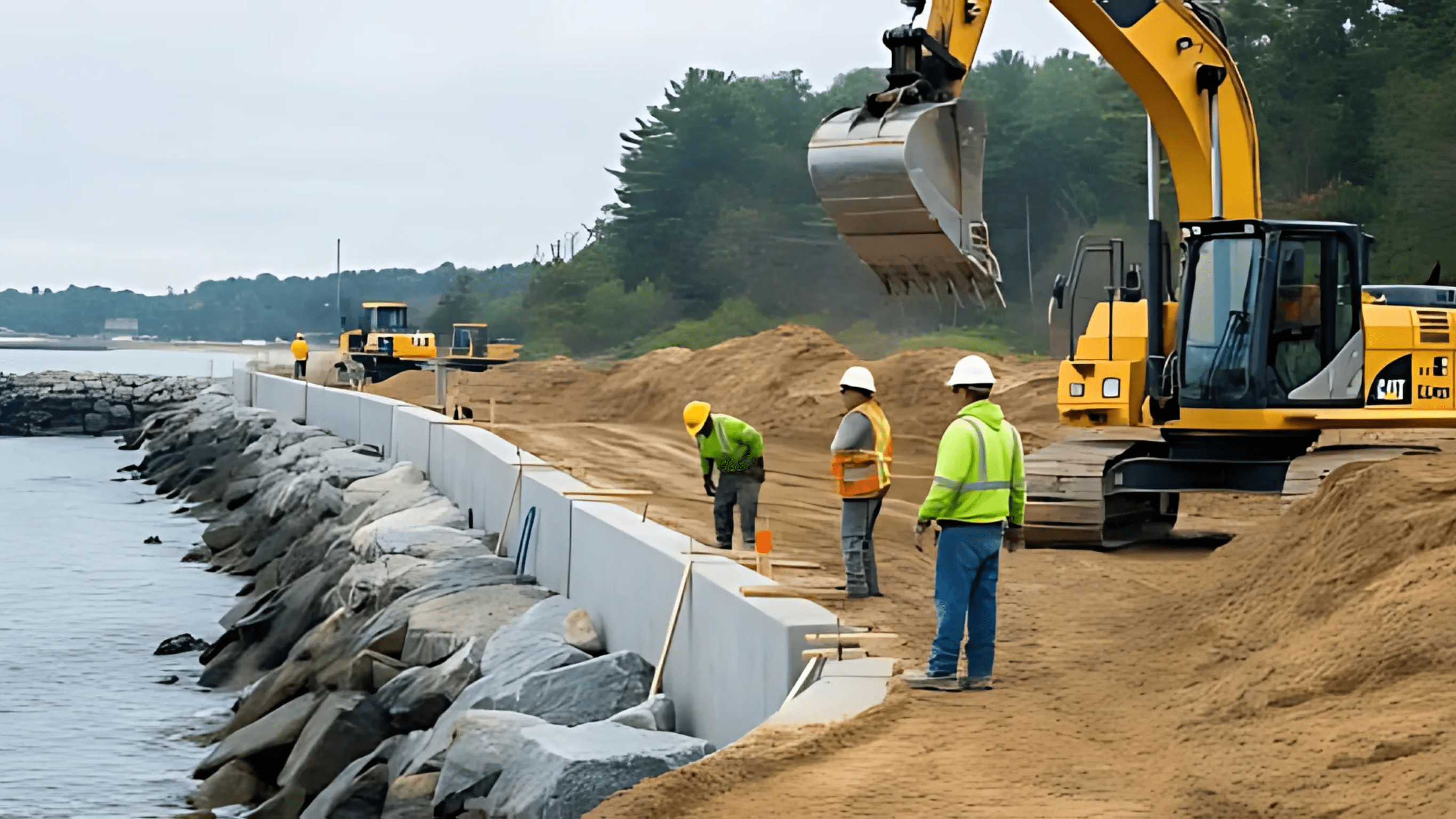
Living near the sea or ocean is a dream for many, but it comes with challenges like coastal erosion and land loss caused by storms, high tides, sediment displacement, and powerful waves. These factors can significantly impact the stability and safety of your land and property.
For Florida’s Gulf Coast, increased coastal erosion due to rising sea levels, hurricanes, and tidal activity has become a pressing concern for coastal communities. This increased coastal erosion threatens waterfront homes, businesses, ecosystems, and the stability of the coastline. Without intervention, it can lead to damage to structures, costly repairs, and a loss of property value.
A seawall provides property owners with a practical and durable solution to these issues, reducing erosion, preserving the coastline, and safeguarding your investment. Acting as a barrier, seawalls absorb and deflect wave energy, preventing shoreline erosion and protecting your land, beaches, and waterfront structures.
By preserving natural resources like wetlands and beaches, and preventing sediment displacement, seawalls also contribute to long-term resilience. Not only do they protect your property, but they also contribute to maintaining the ecological balance of the coastline by mitigating the effects of the rising sea level and stabilizing rocks and soil along the coast.
Summit Marine Development specializes in custom seawall construction tailored to Florida’s unique coastal needs, ensuring both durability and peace of mind. Our expertise in designing and constructing seawalls means you can trust them to deliver solutions that meet the specific challenges of your location, making your dream of living by the sea sustainable and secure.
What Is a Seawall, and Why Is It Important?
A seawall is a structure designed to shield land, beaches, and coastlines along the waterfront from erosion and flooding by absorbing and deflecting wave energy. In addition to protecting the coastline, seawalls enhance property value and provide security for coastal homes, businesses, and structures.
Florida’s coastline faces growing challenges from erosion, sea level rise, and stringent complex laws regulating coastal construction. Seawalls help protect both private and public spaces from sea, while reducing environmental impact.
Summit Marine Development designs seawalls that combine functionality, compliance, and durability, offering long-lasting solutions for waterfront property owners.

Understanding Coastal Erosion
Coastal erosion occurs due to natural events such as storms, wave activity, and tidal fluctuations, as well as human activities like sand mining and development near beaches. The impact of coastal erosion can lead to land loss, habitat destruction, increased flooding, and property damage.
Beach erosion is especially detrimental to local economies and ecosystems, threatening marine habitats, wetlands, and wildlife. Addressing these challenges requires innovative seawall solutions that stabilize rocks, soil, and sand, against erosion while preserving wetlands and beaches.
Factors to Consider When Choosing a Seawall
1. Environmental Conditions
- Wave Energy: High-energy coasts require materials like concrete or steel to withstand strong waves, while moderate conditions may allow for vinyl.
- Tidal Fluctuations: A seawall should adapt to changing sea levels and water conditions without losing effectiveness.
- Soil Type: Sandy shores may need deeper foundations, while rocky bases provide natural stability.
2. Longevity and Durability
- Durability: Materials like concrete and steel offer decades of protection with minimal yearly upkeep.
- Aesthetics: Rock revetments, with their natural appearance, blend well with the environment but require more frequent upkeep.
3. Regulatory Compliance
- Florida’s complex laws govern coastal construction to keep erosion rates ensure wetland protection and minimize environmental impact. Summit Marine Development streamlines the permitting process, ensuring your seawall project meets all regulations and stays environmentally responsible.

Types of Seawalls
- Vertical Seawalls: Best for high-energy areas but may increase erosion at the base.
- Curved/Stepped Seawalls: Dissipate wave energy effectively but have higher initial costs.
- Rip Rap (Rock Revetments): Natural-looking, eco-friendly, and effective at reducing wave impact but require more frequent attention.
- Vinyl Seawalls: Lightweight, corrosion-resistant, and affordable, but less durable for high-energy waves.
- Concrete Seawalls: Extremely durable, low-maintenance, and ideal for high-energy areas, though more expensive to install.
- Wood Seawalls: Cost-effective, natural-looking barrier made of treated wood, designed to protect shorelines from erosion and water impact, ideal for use in calm water.
Steps to Choose the Right Seawall
- Assess Your Shoreline: Hire a professional to evaluate erosion rates, wave action, and soil type.
- Set a Budget: Vinyl is cost-effective for moderate ocean conditions, while concrete and steel offer durability for high-energy beaches.
- Choose Materials Wisely: Balance cost, durability, and aesthetics to ensure the seawall meets your needs.
- Plan for Regular Inspections: Regular inspections and minor repairs prevent larger issues, extending the seawall’s lifespan.
- Factor in Aesthetics: Select a design that complements your property while integrating seamlessly with the surrounding landscape.

Why Choose Summit Marine Development?
Summit Marine Development specializes in seawall construction designed to both coastal communities and address Florida’s specific challenges, including coastal erosion, rising sea levels, and the preservation of natural habitats. We provide:
- Custom Solutions: Tailored designs to protect your property and meet your specific project needs.
- Regulatory Expertise: Simplified compliance with Florida’s complex coastal laws.
- Quality Craftsmanship: Durable seawalls built to withstand waves, tidal fluctuations, and other environmental challenges.

Conclusion: Protect Your Shoreline with Confidence
Choosing the right seawall is critical for safeguarding your property from coastal erosion, strong waves, and flooding while preserving local ecosystems. A well-designed seawall not only protects your land and property but also contributes to the sustainability of wetlands, beaches, and marine habitats.
With Summit Marine Development, you’ll benefit from expertly crafted seawalls built to withstand Florida’s unique challenges. Our innovative solutions ensure both property protection and environmental preservation, so your coastal land remains resilient for years to come.
Contact us today for professional seawall construction and repair services, and enjoy the peace of mind that comes with long-term durability, sustainability, and protection for the natural resources of your land.
FAQs
1. How do I choose the right material for my seawall?
A professional assessment of wave energy, wave activity, soil type, and tidal fluctuations will determine the best option. Concrete is ideal for high-energy coasts, while vinyl works for moderate ocean conditions.
2. How often should seawalls be maintained?
Annual maintenance and post-storm inspections of coastal homes are essential to identify and address potential damage early.
3. Can seawalls be eco-friendly structures?
Yes, eco-conscious designs like rock revetments can support marine habitats and wildlife while providing shoreline protection.
4. How long does a seawall last?
Concrete and steel seawalls can last 50+ years with proper upkeep, while vinyl typically lasts 20–30 years.
5. What is the cost of a seawall?
Costs vary based on materials, project location, and size. Vinyl is more affordable, while concrete and steel involve higher upfront costs but offer greater durability and longevity.


